Bread is probably as old as man. This ubiquitous food has been with us since the dawn of our civilization of beyond.
Beloved and versatile, bread is really one of those foods that cross cultures. With us ever since we first domesticated plants, it hasn’t always been made from wheat flour.
Early bread was probably made with the flour of whatever seed was easily available. There is archaeological evidence of flour being used to make bread 30,000 years ago.
Bread at this time would not really have been recognisable as bread that you buy today, and it would have been unleavened. Unleavened bread has not had a raising agent, such as yeast added to it.
Agriculture and Bread
It wouldn’t be until about 10,000 years ago that Neolithic man began to grow wheat and barley specifically to harvest the grain. At this point, bread began to take on a form that we would recognise today.
At the same time, Asia and American cultures would develop rice and maize-based bread respectively.
Leavening would have been discovered early on, as natural wild yeast would easily have infected bread dough as it was being made.
Early bread was leavened deliberately in exactly this way – the dough would be left to ferment naturally. Later, fermented dough from a previous days bread would be used as a starter and the cycle would be continued indefinitely.
Tradition Of Home Bread Making
And really, bread making didn’t change all that much. For centuries bread was a product that was created at home for those at home.
Usually made fresh each day, or regularly throughout the week, bread would have been unique to the area or even home that made it.
It is this basic simplicity and unchanging method of production that makes bread the fundamental iconic food that it truly is.
Later Developments
Obviously, having a good source of yeast would be a bonus for any regular bread maker.
Specific strains of yeast would go on to make unmistakeable bread flavours, and the art of making a sough dough starter is an ancient skill.
This technique allows a wild yeast culture to be kept growing indefinitely, using a little each day and adding to the culture to keep it going.
As brewing became more popular, bread makers would start to obtain their yeast from the brewery, simply because the brewer would have plentiful yeast that he simply didn’t need.
But the defining moment in bread’s history came with new sterile culture techniques, the isolation of specific baker’s yeast, saccharomyces cerevisiae, and eventually the development of packaged, dried yeast.
It was then that bread could be made easily at home or in the production line with no prior effort to obtain live yeast culture.
Unleavened Bread
Despite the popularity of the leavened bread that we are all used to, cultures around the world all have unleavened, or un-risen varieties. Flatbreads such as pita, naan and torta continue to staple foods the world over.
Some flatbreads are actually leavened, but un-risen, so the distinction between them is somewhat murky.
Still A Staple
Despite being overtaken by modern production methods, bread still is, and forever will be a staple of diets around the world.
Easy to make, cheap and tasty, bread’s appeal is timeless.









